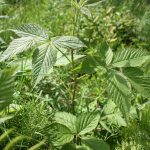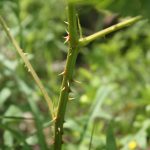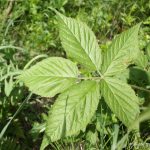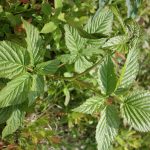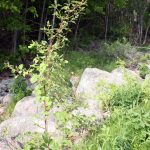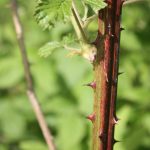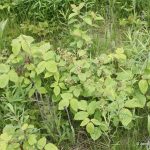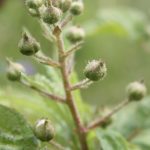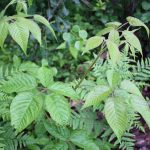Blackberry
Prepared by Jennifer L. D’Appollonio, Assistant Scientist, University of Maine, Orono, ME 04469. Updated February 2018.
Scientific name: Rubus spp.
Common name(s): blackberry, bramble
Links: USDA PLANTS Profile, NPIN Profile, Go Botany
Images: (to see enlargements [PC]: click on image, then right click and choose “view image”)
- Young plant, end of May
- Young stem, end of May – note grooves and stout prickles
- Palmately compound leaf
- Often tall arching or trailing canes
- Mature stem
- Mowed blackberry, early June
- Pre-flower, early June
Description:
-Rosaceae family
– two types of canes: primocanes (1st yr, vegetative) and floricanes (2nd yr, bears flowers)
Leaves are
- palmate
- 5-7 leaflets
- floricane leaves can have 3 leaflets
– large prickles similar to rose thorns, sometimes hairy branches 4″-12″ long.
– can be difficult to identify species without flowers/fruit, both because Rubus species hybrids are common and because plants in wild blueberry fields are mowed/burned regularly
– may be confused with other Rubus such as raspberries and black raspberries, but fruit ripens later and center portion (rasp) comes off with the fruit (not hollow as in raspberries)
– generally flowers late May to late July in ME
Habitat:
-full sun
-well drained soil
Wildlife Benefits:
-attracts nectar feeding butterflies
-birds and small mammals eat the fruit
-birds nest in the brambles and mammals use it as protection
Natural History:
-Bramble derived from “brymbyl” meaning prickly
Source(s):
Kagan , Carol. “Brambles (Rubus Spp.) — 2020 Herb of the Year.” Penn State Extension, 19 Jan. 2021, extension.psu.edu/brambles-rubus-spp-2020-herb-of-the-year.
Hansen, R.W., S.B. Hansen and E.A. Osgood. 1991. Reproductive phenologies of selected flowering plants in eastern Maine forests. ME Agric. Exp. Station Tech. Bull. 143. 17 pp.

